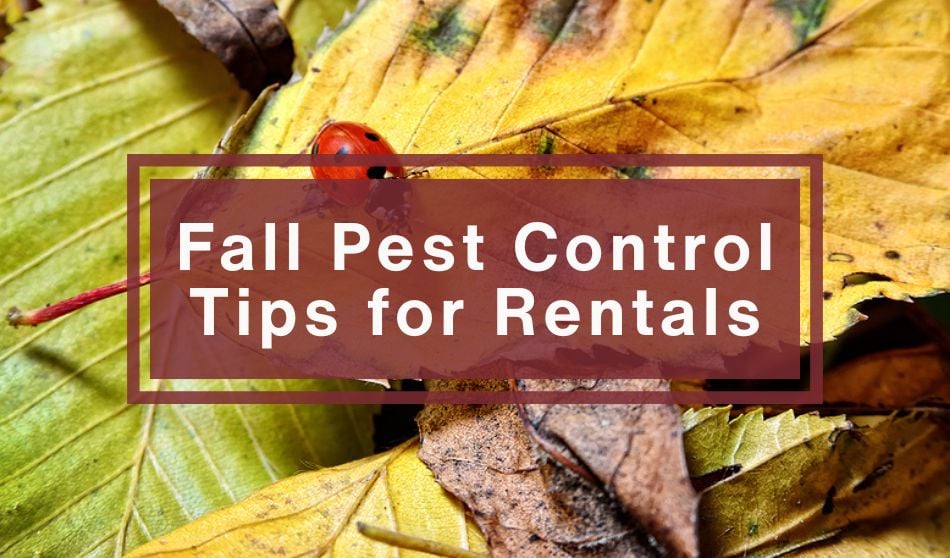
Fall pest control for your rental should be a focus for landlords and property managers as it becomes time to address seasonal maintenance. From looking out for common fall pests, to offering general tips for tenants to prevent pests through the autumn season and beyond, there are plenty of mitigation techniques that can prevent an infestation.
Pests at your rental property can be a problem any time of the year, but fall weather can bring some unique challenges and requirements regarding pest control and mitigation. As the temperatures drop and pests begin seeking a warm cozy logging, make sure that spot isn’t your rental.
This seasonal shift can bring an influx of unwanted guests, including rodents, spiders, and insects. Whether you are a landlord, property manager, or are a renter yourself, there are some important precautions you can take to keep the space pest-free throughout the autumn season and beyond.
Common Pests in the Fall
In the pest prevention industry, certain pests are known as occasional invaders. These are seasonal pests that appear indoors based on the climate or season. These overwintering pests are ones that typically will stay hidden during the winter and cold seasons but will emerge as temperatures rise.
Unfortunately, ‘staying hidden’ could mean seeking shelter in a rental property. According to pest experts, there are twelve common fall pests that you may find in a home as these insects, arachnids, and animals prepare for overwintering.
12 Common Fall Pests to Look Out for:
- Cigarette Beetle
- Confused Flour Beetle
- Spider Beetle
- Larder Beetle
- Centipede
- Stink Bug
- Boxelder Bug
- Asian Lady Beetle
- House Mouse
- Norway Rat
- Silverfish
- Fruit Fly
Prevention Measures for Fall Pest Control
Thankfully, with these overwintering pests, seeing a few does not necessarily signify a full-blown infestation, and there are ways that you can mitigate the risk that these pests will continue to seek shelter within the rental property. Landlords and property managers should incorporate pest mitigation strategies into their fall property maintenance procedures.
Pest Tips for Landlords
As part of annual maintenance, landlords should be tackling a few seasonal tasks each autumn. Checking the exterior for any holes or cracks and conducting general maintenance are essential each season, but can be crucial in the colder months as weatherproofing and pests prevention becomes more important. Trimming exterior bushes and keeping them from getting too close to the building can also remove excess debris that pests can hide inside.
Keep in mind that small critters and pests like rats, mice, and even squirrels can burrow in your property’s insulation and cause ice damage to your roof. To prevent an infestation, caulk small holes and cover large holes with hardware cloth.
The Humane Society recommends the following tips for animal-proofing your property: caulk for small holes, staple or screw hardware cloth over larger holes, or make permanent repairs. Bug screen (1/4 inch hardware cloth) will not hold up to stronger animals, such as raccoons, so 16 gauge 1×1 inch steel mesh is recommended for raccoons. Specifically for squirrels, solid aluminum flashing is the exclusion material of choice.
Learn more: Are Your Rentals Ready For Fall?
Pest Tips for Tenants
Avoiding a pest problem is far easier than getting rid of an infestation once it has occurred. They say an once of prevention is worth a pound of cure, and there’s no doubt that when it comes to dealing with pests, that prevention is the best (and easiest method) to avoid the issue.
Learn more: Simple Pest Elimination Tricks for Renters
There are a few simple pest mitigation techniques that can go a long way:
- Vacuum often: Getting rid of crumbs and dust and even organic matter like dead skin and hair can give potential pests less to be attracted to within your home.
- Clear Spider Webs: Too many spiders may need professional intervention, but keeping spiders at bay can be as simple as knocking webs down with a broom or duster.
- Remove Clutter: Excess clutter ensures that pests have more places to nest, particularly if there is enough clutter that the area is not trafficked.
- Essential Oils: Some essential oils can deter various pests, peppermint or eucalyptus oil can be commonly recommended depending on the pests you’re seeking to deter.
- Spices and Herbs: Strong scents may be offputting to specific pests, but keep in mind that a home remedy is only effective if you’re dealing with a few bugs and not an infestation.
Learn more: Tenant Tips for Pest Infestations in a Rental
When should landlords check in with a professional pest control company?
If a pest issue is causing harm to your property, creating an unsafe or unsanitary environment, or simply getting in the way of your tenant’s enjoyment of the space, it is time to seek a professional pest expert’s opinion.
Who pays for pest extermination services, if needed?
Lease agreements should explicitly have stipulations for pest elimination and its responsibility. Generally, it is in the landlord’s best interest to protect the property and quickly address the issue to ensure that the rental is legally habitable. Landlords and property managers can be fined if pest management is affecting habitability.
Learn more: Landlord Forced to Pay $1.6 Million Due to Pest Infestation
If tenant actions caused an infestation, landlords may have recourse to charge for the services or deduct from the tenant’s security deposit depending on your area’s landlord-tenant laws and your lease agreement’s language. Professional exterminators can often attest to the nature of an infestation and determine if tenant habits have invited pests. In cases where the true source cannot be determined, remember that it is to both tenants’ and landlords’ benefit alike to eliminate the problem as quickly and effectively as possible, so be willing to explore compromises.





